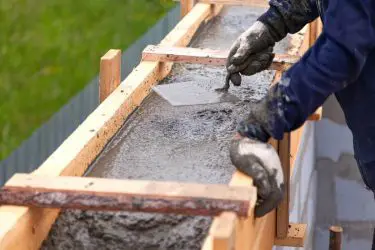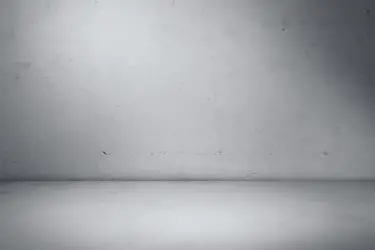When you poured your beautiful new concrete driveway, you probably had a very specific idea of how it was supposed to look. You probably didn’t imagine it ever developing ugly black splotches.
Common reasons for concrete turning black are trowelling too much (known as trowel burn) and inconsistent water ratio in multiple concrete batches used in the same project. Other causes could be uneven curing and the use of calcium chloride (de-icing salts, e.g.). Some black discoloration can be removed while others cannot.
So is it the end of the world if your concrete starts turning black? No. Not at all. But it can certainly be very disappointing, and it’s understandable to want to know how this happened.

Table of Contents
What Causes Concrete Discoloration?
There are many possible causes for discoloration in concrete, and in many situations, it can be near impossible to tell which one applies to your slab.
Inconsistent Mixing
A lot of what gives concrete its color is the cement that’s used in its production. During the curing process, this cement can take on different colors depending on the mix’s water content.
This means that if whoever mixed the concrete needed to mix two different batches and the second batch had a different amount of water than the first, one of the two batches will end up darker than the other.
For most large-scale projects, this means that the fault lands squarely on the shoulders of the ready-mix company from which you ordered your concrete. As a result, there isn’t really much that you can do to prevent this from happening.
Using More Than One Kind Of Cement
Just like water content can be a major factor in whether your concrete finishes uniformly, different kinds of cement can also take on different colors when all is said and done.
This too can cause major discoloration. Fortunately, this is something that you can control pretty easily.
It’s the same with ready-mix companies. Most of them are being pretty careful to make sure that this particular mistake doesn’t happen. However, nobody can avoid mistakes 100% of the time.
Using A Cement Replacement
Cement is terrible for the environment, so many people and companies will mix their concrete using a different binding agent. The most common of these are Fly Ash and Slag.
Fly Ash is a byproduct of coal power plants. This isn’t usually used on its own, rather, it’s usually mixed with about 20% portland cement.
This cement replacement can often cause concrete to take on color, but it won’t usually turn the concrete black. Instead, it will turn a slight brown tinge.
Slag is a byproduct of refining iron and steel. It has many similar properties to the cement usually used in concrete, which makes it a fairly effective replacement. Slag concrete tends to have a lighter color than usual, making discoloration all the more noticeable.
Calcium Chloride
Calcium chloride is a particular kind of de-icing salt that is often used over concrete. Unfortunately for us, it is a major factor in a lot of instances of discoloration.
While it is very good for getting rid of dangerous ice, it is also very bad for your concrete.
Other De-icing Salts
The problem with these isn’t the salts themselves, but the oils that end up attached to the salts during processing. These oils can seep into the concrete and cause dark spots to emerge.
Like with calcium chloride, the best thing to do to protect your concrete is to find an alternative to these salts, but if you do need to use them you should always test the salts on a dedicated testing spot to make sure they won’t be doing any damage.
Fortunately, the spots caused by de-icing salts can be cleaned off with just a little elbow grease.
Water Damage
If a slab of concrete is placed so that water is frequently falling, dripping, or collecting on its surface it can quickly begin to receive damage in the form of indentations and dark spots.

Fortunately, this is one of the easiest kinds of discoloration to fix! Still, it’s probably easier to place your concrete slab so that this won’t happen in the first place.
Trowelling Too Much
While making your concrete smooth, it can be tempting to try and make the concrete look absolutely perfect.
However, trowelling too much can pull water from deeper in the slab to the surface, which can easily lead to damage including discoloration.
Troweling too much is commonly known as trowel burn.
Insufficient Curing
After the concrete has been poured and hardened a little bit, it needs to be taken care of for a little while during what’s known as the curing process. During this time, the cement is slowly reacting with the water in the mixture, and for this reaction to take place, there needs to be water in the cement.
This reaction can take quite a while to finish.
It’s generally a good idea to either seal the concrete or put in the effort to keep the entire concrete slab wet for about a week before considering it finished.
If this isn’t done, the concrete can end up with serious structural problems. It can also end up with uneven color, as some parts of the concrete have completed the curing process and others haven’t.
This is probably the most difficult kind of discoloration to fix since the problem is much deeper than just the surface.
Any Combination Of The Above
For any of these problems, they could easily be compounded by the existence of other problems in the mixture or the environment of the concrete.
This is one of the reasons that it can be so hard to tell why concrete has started to discolor. It could be something that happened before the concrete was even poured, it could be something in the environment around it, and it could be a combination of multiple different things!
The discoloration can also be stains of stuff like dirt, mold, or oil, for example. This is something that you usually can fix by cleaning. See our tips for removing black stains from concrete further down this article.
How to Prevent Concrete Turning Black
An important note to make here is that even when you do everything right, you can still end up with discoloration. However, doing the following things will certainly decrease the chances of this happening.
- Don’t use Calcium Chloride. If you have control over this, then just don’t use calcium chloride. Many experts agree that just avoiding this one chemical can drastically decrease the chances that your concrete will discolor.
- Learn how to trowel from an expert. It can be pretty difficult for beginners to get trowelling right. It’s easy to start too early or keep going for too long. Either look up a tutorial online or ask a contractor what they do.
- Make sure the slab cures uniformly. This is probably the most effective way to prevent discoloration. Either use a chemical sealer on your slab as soon as it’s hard enough or commit to keeping it wet for a week after it’s been poured.
- Make sure the slab is properly equipped to repel water. Many beginners pour their concrete slabs to be perfectly level with no incline. However, this means that any water that falls on the slab will stay there, which can increase the chances of the slab receiving water damage. Especially in wet climates, outdoor concrete slabs should always have a slight incline to them facing away from structures and towards the soil. This will help prevent water from standing on the surface of the concrete and causing problems.
- Don’t use high-alkali cement. Types of cement with high alkali contents are more likely to end up causing discoloration in concrete. Just not using them will go a long way.
So there’s a pretty limited number of things you can do to prevent discoloration. A lot of the things that cause concrete to turn colors are just out of your control.
How to Remove Black Stains From Concrete
Oftentimes discoloration in concrete can be hard to remove if not prevented. But luckily, sometimes concrete that has turned black can also be just stains of dirt, mold, oil, for example.
This is, fortunately, something that you usually can fix by cleaning. So, here are our tips for removing black stains from concrete.
Repeatedly washing the black spot with hot water and scrubbing it with a hard brush can remove some black stains from concrete. For more stubborn stains, use a solution of water and 1-10% hydrochloric acid. If that doesn’t work, try a 20-30% water and diammonium citrate solution and let it sit for 15 min before washing away.
If you don’t know what kind of stain it is, it’s best to start testing to remove the black spots with just water and some scrubbing. Since that is the easiest way, you should always try that first. There is no need to use acid or chemicals if it isn’t necessary.
But remember, you might need to repeat the process several times for some stains to disappear.
Also, you might have to scrub the stain quite intensively for a while for anything to happen.
The specific method you’ll need to clean your concrete is known as flush and scrub, and it’s as simple as flooding the concrete with hot water and then scrubbing it thoroughly with a hard brush. It’s as simple as that.
But like I said, just water isn’t enough for more stubborn stains, unfortunately.
If only water doesn’t remove the black stain, your next best shot is to apply a solution of water and hydrochloric acid that’s only 1% acid. If one percent doesn’t work, you can consider upping the concentration to 5%, and then to 10%.
The cleaning process is the same as the simple one with only water. Just soak the affected spot and scrub it thoroughly.
If that doesn’t work, move into the next method, the 20-30% water and diammonium citrate solution.
As I mentioned, this solution should sit on the stain for about 15 minutes. Be sure to apply the solution on a dry surface for best results. The resulting white gel can be diluted in water and then brushed away with water.
It might be enough to just wash it away, but adding some scrubbing can be good for stubborn stains.
If you can’t remove the black discoloration in any way, you can just paint the concrete that’s been affected. This will cover up the problem, making it invisible.
Remember that most of the time discoloration is a simple aesthetic problem on a perfectly functional slab of concrete. That means that even if no cleaning method works, you won’t actually be losing anything by simply painting over it.
However, in some cases, the discoloration can be caused by something that could hurt your concretes integrity for example. Always contact a professional if you’re unsure.




